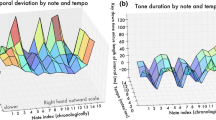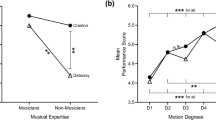Abstract
Differences between recorded repetitions of one’s own movements are detected more readily than are differences between repetitions of others’ movements, suggesting improved visual discrimination due to heightened resonance in the observer’s action system and/or relatively accurate internal action simulation (Daprati et al. in Conscious Cogn 16:178–188, 2007). In Experiment 1, we attempted to replicate this finding in the auditory modality. Pianists were recorded playing musical excerpts three times and later judged whether pairs of recordings were the same take or different takes of the same excerpt. They were no better at distinguishing different takes of their own playing than those of other pianists’ playing, even though discrimination and self-recognition were well above chance. In Experiment 2, the same pianists tried to detect small local timing deviations that had been introduced artificially. They were better at detecting such deviations in their own performances than in those of another pianist, but only if the deviations were placed at points of a pre-existing self-other difference in local timing. In that case, pianists’ ability to predict their own characteristic action pattern did aid their perception of temporal irregularity. These results do not support the perceptual sharpening hypothesis of Daprati et al. in the musical domain, but they do suggest that pianists listening to performances generate idiosyncratic temporal expectations, probably through internal action simulation.

Similar content being viewed by others
Notes
A change of 20% seems large, but local deviations from expressive timing profiles are not easy to detect. From Repp’s (1998b) data a mean detection (hit) rate of about 70% can be predicted for hesitations of that magnitude, but in that study a single musical excerpt was presented repeatedly. With many different excerpts, each presented only once, the detection rate was expected to be lower.
First, we determined the mean number of positions in the music where a deviation could occur. Across the 12 excerpts, with the initial and final two positions excluded, this number was 63. Given that four deviations occurred in each excerpt and a lenient scoring criterion (±1 position) was used, there was an average probability of 12/63 = 0.19 that a random response would be scored as a hit. In other words, about 1/5 of the music consisted of “signal zones” and 4/5 consisted of “noise zones.”
Like most other participants, they were not native speakers of German and presumably failed to understand that they were to listen for artificially introduced hesitations. They probably responded instead to local expressive slowing, which of course can be detected if it is large enough and if such detection is the listener’s intention.
To determine whether local features of the selected performance of each excerpt were intended or not, we could have analyzed the timing profiles of all three renditions of each excerpt by each pianist and examined their consistency. However, this would have added much time to what was already an extremely time-consuming process of stimulus preparation. Thus, some proportion of Type 2 changes may have been introduced at points of unintended deviation in local timing.
References
Calvo-Merino B, Glaser DE, Grèzes J, Passingham RE, Haggard P (2005) Action observation and acquired motor skills: an FMRI study with expert dancers. Cereb Cortex 15:1243–1249
Cross ES, de Hamilton AFC, Grafton ST (2006) Building a motor simulation de novo: observation of dance by dancers. Neuroimage 31:1257–1267
Daprati E, Wriessnegger S, Lacquaniti F (2007) Knowledge of one’s own kinematics improves perceptual discrimination. Conscious Cogn 16:178–188
Flach R, Knoblich G, Prinz W (2004) Recognizing one’s own clapping: the role of temporal cues. Psychol Res 69:147–156
Haslinger B, Erhard P, Altenmüller E, Schroeder U, Boecker H, Ceballos-Baumann AO (2005) Transmodal sensorimotor networks during action observation in professional pianists. J Cogn Neurosci 17:282–293
Iacoboni M, Koski LM, Brass M, Bekkering H, Woods RP, Dubeau M-C, Mazziotta JC, Rizzolatti G (2001) Reafferent copies of imitated actions in the right superior temporal cortex. Proc Nat Acad Sci 98:13995–13999
Jeannerod M (2003a) Simulation of action as a unifying concept for motor cognition. In: Johnson-Frey SH (ed) Taking action: cognitive neuroscience perspectives on intentional acts. MIT Press, Cambridge, pp 139–163
Jeannerod M (2003b) The mechanism of self-recognition in humans. Behav Brain Res 142:1–15
Keller PE, Knoblich G, Repp BH (2007) Pianists duet better when they play with themselves: on the possible role of action simulation in synchronization. Conscious Cogn 16:102–111
Knoblich G, Flach R (2003) Action identity: evidence from self-recognition, prediction, and coordination. Conscious Cogn 12:620–632
Lahav A, Saltzman E, Schlaug G (2007) Action representation of sound: audiomotor recognition network while listening to newly acquired actions. J Neurosci 27:308–314
Loula F, Prasad S, Harber K, Shiffrar M (2005) Recognizing people from their movement. J Exp Psychol Hum Percept Perform 31:210–220
Palmer C (1989) Mapping musical thought to musical performance. J Exp Psychol Hum Percept Perform 15:331–346
Repp BH (1992) Diversity and commonality in music performance: an analysis of timing microstructure in Schumann’s “Träumerei”. J Acoust Soc Am 92:2546–2568
Repp BH (1995) Expressive timing in Schumann’s “Träumerei”: an analysis of performances by graduate student pianists. J Acoust Soc Am 98:2413–2427
Repp BH (1998a) Variations on a theme by Chopin: relations between perception and production of deviations from isochrony in music. J Exp Psychol Hum Percept Perform 24:791–811
Repp BH (1998b) The detectability of local deviations from a typical expressive timing pattern. Music Percept 15:265–290
Repp BH, Knoblich G (2004) Perceiving action identity: how pianists recognize their own performances. Psychol Sci 15:604–609
Rizzolatti G, Craighero L (2004) The mirror-neuron system. Annu Rev Neurosci 27:169–192
Schütz-Bosbach S, Prinz W (2007a) Perceptual resonance: action-induced modulation of perception. Trends Cogn Sci 11:349–355
Schütz-Bosbach S, Prinz W (2007b) Prospective coding in event representation. Cogn Process 8:93–102
Sevdalis V, Keller PE (2009) Self-recognition in the perception of actions performed in synchrony with music. Ann N Y Acad Sci 1169:499–502
Viviani P (2002) Motor competence in the perception of dynamic events: a tutorial. In: Prinz W, Hommel B (eds) Attention and performance XIX: common mechanisms in perception and action. Oxford University Press, Oxford, pp 406–442
Wilson M, Knoblich G (2005) The case for motor involvement in perceiving conspecifics. Psychol Bull 131:460–473
Wolpert DM, Ghahramani Z (2000) Computational principles of movement neuroscience. Nat Neurosci 3:1212–1217
Wolpert DM, Doya K, Kawato M (2003) A unifying computational framework for motor control and social interaction. Philos Trans R Soc B 358:593–602
Acknowledgments
This research was supported by the Max Planck Society and also by National Science Foundation grant BCS-0642506 to BHR. We are grateful to Kerstin Träger for recruiting and scheduling the participants, to Angela Schimming and Regine Steinke for running the experiments and analyzing the data, and to Emily Cross and Günther Knoblich for helpful comments on a draft of the manuscript. We also thank Paolo Viviani and an anonymous reviewer for their suggestions on improving the original manuscript.
Author information
Authors and Affiliations
Corresponding author
Rights and permissions
About this article
Cite this article
Repp, B.H., Keller, P.E. Self versus other in piano performance: detectability of timing perturbations depends on personal playing style. Exp Brain Res 202, 101–110 (2010). https://doi.org/10.1007/s00221-009-2115-8
Received:
Accepted:
Published:
Issue Date:
DOI: https://doi.org/10.1007/s00221-009-2115-8




